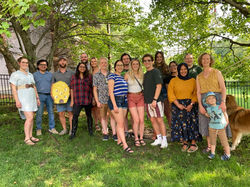Seitenanfang
shade lab
understanding microbiome resilience
Welcome to the website of Ashley Shade's research program at Université Lyon with the Laboratoire Ecologie Microbienne!
#ShadeLab #metagenomics #resilience #LaboratoireEcologieMicrobienne
Microbial communities (also called microbiomes) are composed of up to tens of thousands of different types of microbial members, including bacteria, fungi, viruses, and tiny eukaryotes. These communities perform essential functions for their ecosystems. In our research program, we want to understand how environmental microbiomes respond to stress so that we can manage them to quickly recover and maintain stable functions despite the changing climate. The capacity to recover quickly and fully from a large stress is called resilience.
We want to understand:
-
the relationship between microbial diversity and resilience;
-
the microbial traits and mechanisms that promote resilient communities;
-
how to predict a shift in microbiome performance, and how and when to intervene to prevent it
-
functional redundancy - when more than one microbial population can perform identically- and its importance for stable microbiome performance; and
-
how interactions among different microbes influence resilience.
We know that microbiomes are generally sensitive to changes in their environment and to stress. Excitingly, many microbiomes have an immense capacity for resilience. Therefore, we hypothesize that there are ecological rules of microbiome resilience that can be usefully applied across different environments. Our research is grounded in ecological framework and focused on building transferable theory, approaches, and knowledge of mechanisms that transcend any particular microbiome host or ecosystems. We aspire that this work will broadly advance fundamental and predictive microbiome science.
We have worked in many environments to understand the general aspects of microbiome resilience. We currently study microbiomes from: plant roots, leaves, and seeds; soils impacted by a long-term and severe disturbance (the Centralia, PA coal seam fire); and synthetic communities that we create in the lab. We have also used data mining and meta-analyses to investigate broad patterns of microbial diversity in many environments, including human guts, lakes, waste water treatment, and oceans. We are happy to collaborate to think about resilience in other habitats as well.
keywords: microbial ecology and evolution, soil microbiome, plant microbiome, plant resilience, disturbance ecology, rarity, dormancy, temporal dynamics, environmental microbiology, microbial diversity, macroecology, metagenomics, metabolomics, synthetic communities
Affiliations
Laboratoire Ecologie Microbienne
CNRS - Institute of Ecology and the Environment
Collaborations
Environmental Microbial Genomics Group
unten auf der Seite
















